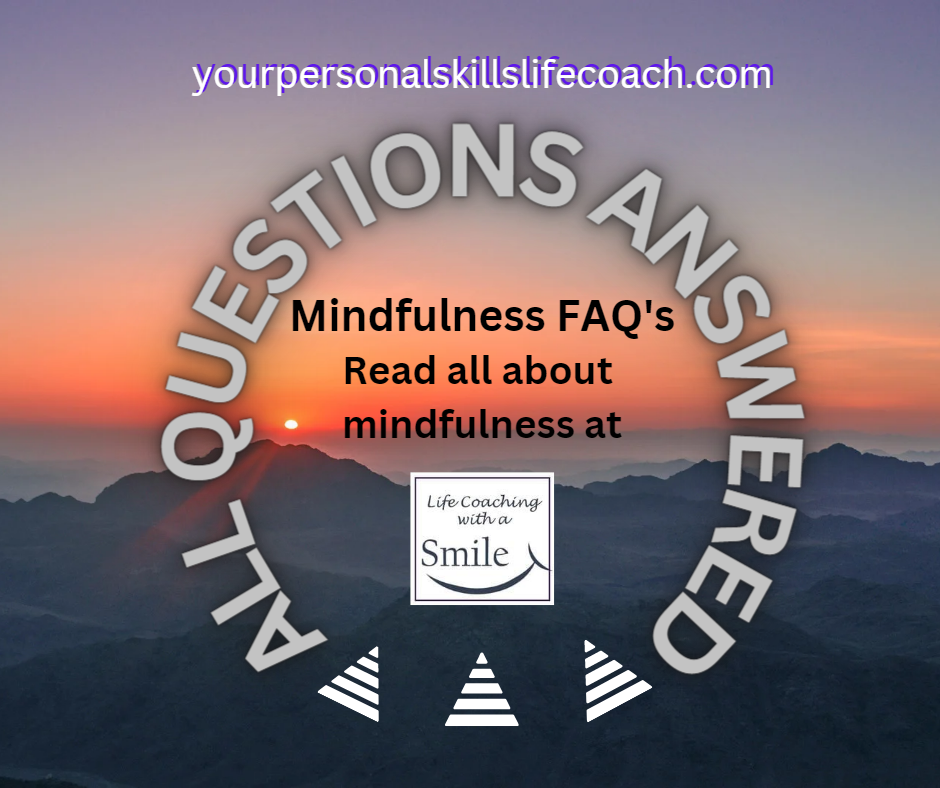As I was about to prepare the stuffing for our Thanksgiving turkey, I answered a phone call from my daughter (visiting in-laws in Kansas City) telling me my grandson was sick and running a temperature. Everything flew out of my head and I started to babble. It took a few seconds for focus and breathing to kick in. Then I tuned back into the conversation. (My grandson is doing ok, now.) This unexpected use of mindfulness got me past at stressful moment. And, mindfulness came in handy several more times that day as I thought about them 500 miles away. To conclude this series of articles mindfulness, we are going to briefly cover ways to achieve mindfulness (other than meditation.) This all leads up to some Mindfulness FAQ’s.

As you can tell from my example above, sometimes stressful situations fly at you unexpectedly. Other times they creep up on you. Sometimes they are just part of our stress-filled daily lives.
Perhaps you have tried meditation and found it’s just not for you. Maybe it is not what you need for a particular situation. Much has been written about mindful meditation, but
“Luckily, meditation and mindfulness are not one in the same. You don’t have to meditate in order to be mindful. Mindfulness is a nonjudgmental awareness of thoughts, sensations, surroundings, and emotions, and meditation is one tool for developing mindfulness but isn’t the only tool.” chopra.com
Mindfulness Methods
We have talked about what mindfulness is and why it works, but you still might feel that you just aren’t getting it. Ironically, for some, the harder they try to become mindful the more stressed they get.
You can find many ways to incorporate mindfulness that don’t require meditation. Some experts say to begin your mindfulness practice by just sitting still and letting thoughts flow without attachment to them. Begin with 15 seconds just doing nothing. Switch off your brain. Doing that a couple times a day are beginning steps to training your brain for mindfulness.
Other ways to bring Mindfulness into your life include:
- Journaling
- Yoga
- Mindful eating
- Active listening
- Deep breathing
- Sitting outdoors
- Routine ( like making the bed or walking the dog)
- Taking a shower
Remember, as you employ any of these techniques, you should be using your seven senses (Sight, Hearing, Touch, Taste, Smell, Motion, Body Position.)
Be Grateful
The last method I want to mention to help with mindfulness is to be grateful. Recognizing the things in your life you feel grateful for creates many positive emotions. These positive thoughts connect us in a good way to the world around us. As we become more positive it becomes easier for us to not attach to an event or stressful situation. Expressing gratitude makes us aware. And as you recall, being aware is the first step in being mindful.
You won’t become a mindful person overnight. It takes practice. But even one small success will start to train your brain. One breathing exercise will lessen your stress. Just one meal when you take time to smell, and taste every bite. One purposeful walk where you let the harsh voices flow through and just be present. You will begin to be aware and take control and then you will be on your way to mindfulness.
11 Mindfulness FAQ’s
People have lots of questions about mindfulness. Many people have asked me the same questions. These frequently asked questions (Mindfulness FAQ’s) show up in the following listing:
What is mindfulness?
The dictionary definition says mindfulness is the practice of purposely bringing one’s attention to the present-moment experience without evaluation, a skill one develops through meditation or other training.
Can anyone become mindful?
Yes. Anyone who is willing to try can learn and use mindfulness at some level. Many grade schools are now teaching mindfulness to help students control emotions. And studies are being done with Alzheimer’s patients to help with memory.
Is mindfulness difficult to learn?
Mindfulness helps you feel more in control of thoughts and emotions so you don’t feel out of control. You have to slow down and notice, without judgment. Mindfulness isn’t complicated – but it can be challenging. You can get started in an hour. You can spend a lifetime trying to master it.
Is mindfulness meditation?
Mindfulness is a state of being. Meditation is one of many methods used to reach it.
How can mindfulness help with pain?
Recent studies of chronic pain show the brain can learn to manage and even relieve pain using deep focus, breathing, and imagery techniques. It will likely take the help of a professional to get to this level.
Is there a mindful way to handle negative thoughts?
Yes. Practice your ABCD:
- A → “Ask yourself, ‘Is it true?’”
- B → “Breathe and let the thought pass through without judging it.”
- C → “Counter it with a positive thought.”
- D → “Dump and release it.”
Do you have any tips to begin mindfulness?
- Breathe/meditate
- Smile, relax, focus find joy in simple pleasures
- Accept yourself, treat yourself as you would a friend
- Affirmations and celebrate your wins
- Live in the moment. Be aware of your surroundings
- Use your 7 senses when eating, observing, talking, walking
- Find resources you trust or take a class or talk with a Coach or other professional
Can I be mindful if I can’t stand quiet?
Certainly. Many people use white noise or music to help. Other people find mindfulness in activities with ambient noise but take concentration like photography, routine chores, eating, guided meditation and others.
What are mindfulness triggers?
They are ways to remind yourself to focus and be aware of your surroundings and emotions so that daily activities can become more intentional and you can become more fluent in mindfulness. I suggest leaving yourself a note at night to start your day in a mindful way and use strategically placed post-it notes to remind yourself to smile and breathe. Set alarms to get up and take breaks. Leave a note on the fridge or table to remind yourself to slow down to eat. Above all, be grateful every day.
I think I have a mental block against mindfulness.
Why can’t I get it?
As mentioned above it’s not complicated, but it can be challenging. Make sure you are able to focus. Ask yourself, are you tired, hungry, in pain, trying to rush, in an emotional crisis, or not committed? Some people find a guided meditation a great way to start.
Is mindfulness just a passing fad?
Some experts say the jury is still out. A growing body of science suggests otherwise. There continue to be studies done on the effectiveness of mindfulness and more known every day. Proper understanding and guidance can be crucial in mindfulness practice. Mindfulness is not an easy cure-all. It is also not worthless, a sham, or harmful (if not misused.)
Conclusion
We end as we began. What is mindfulness? Mindfulness is a state of being where you focus your attention on the present moment—and you accept it without judgment (No blaming if you lose your temper. No negative behavior if something doesn’t go right, no beating yourself up.) Accept the situation and let it pass.
Scientists continue to examine mindfulness and find it a key element in stress reduction and overall happiness.
By mastering our ability to intentionally direct our attention and keep it there, and removing our attention from anything that is negative or not serving us, we can begin to gain clarity about our reality and goals and make them happen.
Related Articles:
- Mindfulness
- Mindfulness: What is it?
- Mindfulness Practices
- Happiness Mindfulness
- Mindfulness Self-Assessment
- Mindfulness for Health and Happiness
- A Tool to Control Stress: Mindfulness
- Mindfulness through Meditation
* Please leave a comment below. You may comment anonymously or you may use your first name. We may post or quote your comment on the website. We will never post or share your last name, email address or any other personal identifying information.
